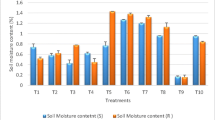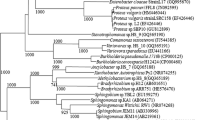Abstract
Effect of soil salinity on physico-chemical and biological properties renders the salt-affected soils unsuitable for soil microbial processes and growth of the crop plants. Soil aggregation around roots of the plants is a function of the bacterial exo-polysaccharides (EPS), however, such a role of the EPS-producing bacteria in the saline environments has rarely been investigated. Pot experiments were conducted to observe the effects of inoculating six strains of EPS-producing bacteria on growth of primary (seminal) roots and its relationship with saccharides, cations (Ca2+, Na+, K+) contents and mass of rhizosheath soils of roots of the wheat plants grown in a salt-affected soil. A strong positive relationship of RS with different root growth parameters indicated that an integrated influence of various biotic and abiotic RS factors would have controlled and promoted growth of roots of the inoculated wheat plants. The increase in root growth in turn could help inoculated wheat plants to withstand the negative effects of soil salinity through an enhanced soil water uptake, a restricted Na+ influx in the plants and the accelerated soil microbial process involved in cycling and availability of the soil nutrients to the plants. It was concluded that inoculation of the EPS-producing would be a valuable tool for amelioration and increasing crop productivity of the salt-affected soils.
Similar content being viewed by others
References
Alami, Y., Achouak, W., Marol, C. and Heulin, T., (2000). Rhizosphere soil aggregation and plant growth promotion of sunflowers by an exopolysaccharide-producing Rhizobium sp. strain isolated from sunflower roots. Appl. Environ. Microbiol., 66, 3393–3398.
Amellal, N., Burtin, G., Bartoli, F. and Heulin, T., (1998). Colonization of wheat roots by EPS-producing Pantoea agglomerans and its effect on rhizosphere soil aggregation. Appl. Environ. Microbiol., 64, 3740–3747.
Anonymous, (1980). Standard methods of analysis for soil, plant tissue, water and fertilizer. Philippine Council for Agriculture and Resource Research, Los Bañlos, Laguna, 194.
Ashraf, M., Berge, O., Azam, F. and Heulin, T., (1999). Bacterial exo-polysaccharides and productivity of the salt affected soils: I. Diversity of exo-polysaccharide producing bacteria from the rhizosphere of wheat (Triticum aestivum L.) grown in normal and saline Pakistani soils. Pak J Biol Sei., 2, 201–206.
Ashraf, M., Hasnain, S., Berge, O. and Mahmood, T., (2004). Inoculating wheat seedlings with exo-polysaccahrides producing bacteria restricts sodium uptake and stimulates plant growth under salt-stress. Biol. Fertil. Soils., 40, 157–162.
Atkinson, D., (2000). Root characteristics: why and what to measure. In: Root Methods: A handbook. Smit, A. L., Bengough, A. G, Engels, C, van Noordwijk, M., Pellerin, S. and van de Geijn, S. C. (Eds.). Springer-Verlag, Berlin, Heidelberg, Germany. 1–32.
Bacillio, M., Rodriguez, H., Moreno, M., Hernandez, J. R and Bashan, Y., (2004). Mitigation of salt stress in wheat seedlings by a gfp-tagged Azospirillum lipoferum. Biol. Fertil. Soils., 40, 188–193.
Bashan, Y, Moreno, M. and Troyo, E., (2000). Growth promotion of the seawater-irrigated oilseed halophyte Salicornia bigelovi inoculated with mangrove rhizosphere bacteria and halotolerant Azospirillum spp. Biol. Fertil. Soils., 32, 265–272.
Bezzate, S., Aymerich, S., Chambert, R., Czarnes, S., Berge, O. and Heulin, T., (2000). Disruption of the Paenibacillus polymyxa levansucrase gene impairs its ability to aggregate soil in the wheat rhizosphere. Environ. Microbiol., 2, 333–342.
Chenu, C. and Guerif, J., (1991). Mechanical strength of clay minerals as influenced by an absorbed polysaccharide. Soil Sei. Soc. Am. J., 55, 1076–1080
Clarke, L. J., Whalley, W. R. and Barraclough, P. B., (2003). How do roots penetrate strong soil? Plant Soil, 255, 93–104.
Czarnes, S., Hallett, P. D., Bengough, A. G and Young I. M., (2000). Root- and microbial-derived mucilages affect soil structure and water transport. Eur. J. Soil Sei., 51, 435–443.
Gouzou, L., Burtin, G, Philippy, R., Bartoli, F. and Heulin, T., (1993). Effect of inoculation with Bacillus polymyxa on soil aggregation in the wheat rhizosphere: preliminary examination. Geoderma, 56, 479–490.
Jeschke, W. D. and Wolf, O., (1988). External potassium is not required for root growth in saline conditions: Experiments with Ricinus communis L. Growth in a reciprocal split-root system. J. Exp. Bot., 39, 1149–1167.
Kuzyakov, Y. and Larionova, A. A., (2005). Root and rhizomicrobial respiration: A review of approaches to estimate respiration by autotrophic and heterotrophic organisms in soil. J. Plant Nutr. Soil Sei., 168, 503–520.
Marshall, K. C, (1975). Clay mineralogy in relation to survival of soil bacteria. Anuu. Rev. Phytopathol., 13, 357–373.
McCully, M. E. and Canny, M. J., (1988). Pathways and processes of water and nutrient movement in roots. Plant Soil, 111, 159–170.
Miller, K. J. and Wood J. M., (1996). Osmoadoptation by rhizosphere bacteria. Annu. Rev. Microbiol., 50, 101–136.
Mohr, H. and Schopfer, P., (1996). Physiology of hormone action. In: Plant Physiology. Lawlor G, and Lawlor D. W. (transi, eds.). Springer-Verlag, Berlin-Heidelberg, Germany, 383–408.
Morel, J. L., Habib, L., Plantureux, S. and Guckert, A., (1991). Influence of maize root mucilage on soil aggregate stability. Plant Soil, 136, 111–119.
Munns, R., (2002). Comparative physiology of salt and water stress. Plant Cell Environ., 25, 239–250.
Nannipieri, P., Ascher, J., Ceccherini, M. T., Landi, L., Pietramellara, G. and Renella, G, (2003). Microbial diversity and soil functions. Europ. J. Soil Sei., 54, 655–670.
Rengasamy, P., Chittleborough, D. and Helyar, K., (2003). Root-zone constraints and plant-based solutions for dryland salinity. Plant Soil, 257, 249–260.
Safaøík, W. O. and Santrùèková, H., (1992). Direct determination of total soil carbohydrate content. Plant Soil, 143, 109–114.
Shen, W., Gomez-Cadenas, A., Routly, E. L., Ho, T-H. D., Simonds, J. A. and Gulick, P. J., (2001). The salt stress inducible protein kinase gene, Esi47, from the salt-tolerant wheatgrass Lophopyrum elongatum is involved in plant hormone signalling. Plant Physiol., 78, 1429–1441.
Song, J. Q. and Fujiyama, H., (1996). Ameliorative effects of potassium on rice and tomato subjected to sodium salinization. Soil Sei. Plant Nutr., 42, 493–501.
Tisdall, J. M., (1994). Possible role of soil micro-organisms in aggregation of soils. Plant Soil, 159, 115–121.
Vanhaverbeke, C, Heyraud, A. and Mazeau, K., (2003). Conformational analysis of the exo-polysaccharide from Burkholderia caribensis strain MWAP71: Impact on the interaction with soils. Biopolymers., 69, 480–497.
Watt, M., McCully, M. E. and Canny M. J., (1994). Formation and stabilization of rhizosheaths of Zea mays L. Plant Physiol., 106, 179–186.
Watt, M., McCully, M. E. and Jeffree, C. E., (1993). Plant and bacterial mucilages of maize rhizosphere: comparison of their soil binding properties and histochemistry in a model system. Plant Soil, 151, 151–165.
Wittenmayer, L. and Merbach, W., (2005). Plant responses to drought and phosphorus deficiency: Contribution of phytohormones in root related processes. J. Plant Nutr. Soil Sei., 168, 531–540.
Author information
Authors and Affiliations
Corresponding author
Rights and permissions
About this article
Cite this article
Ashraf, M., Hasnain, S. & Berge, O. Effect of exo-polysaccharides producing bacterial inoculation on growth of roots of wheat (Triticum aestivum L.) plants grown in a salt-affected soil. Int. J. Environ. Sci. Technol. 3, 43–51 (2006). https://doi.org/10.1007/BF03325906
Received:
Accepted:
Published:
Issue Date:
DOI: https://doi.org/10.1007/BF03325906




